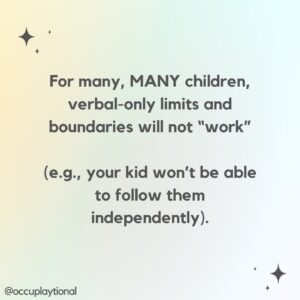Do you understand the difference between wishes, limits, and boundaries?
If you find yourself saying the word “want” or “need”, a lot of times you are expressing a value, a wish, or a feeling. Same with the word “let”, as in “they won’t let me…”
Limits are a decision that you are enforcing about the environment, circumstances, or someone else’s body or actions. Limits are important for the sake of themselves, not for the sake of authority or power.
An example of what I mean by this is that if you had a cliff, and your kid was walking toward the edge of the cliff, if you said, “Don’t go toward the edge of the cliff!” and they kept doing it, you would stop them for the sake of the limit itself. You’re not stopping them because you need to prove you’re the boss, or because you want them to “learn a lesson”. You’re stopping them because the limit itself matters. It doesn’t matter if they stop of their own volition or if you help them stop; it doesn’t matter if they’re happy and thankful or sad and freaked out; what matters is that they didn’t fall off the cliff. The limit was important for its own sake.
Of course, most limits aren’t as directly safety-applicable as an imminent cliff. But the concept still stands. Limits are important to hold for themself, not for some other reason.
Boundaries are a decision that you are enforcing about yourself, your own body. The only person you can control in a boundary is you. Boundaries are important for the sake of you, your own mental health, physical health, well-being.
***
Here are a few examples of some closely aligned wishes, limits, and boundaries that could arise in similar situations to one another.
Wish: The kids need to be asleep by 8:00.
Limit: The kids will be in their bedrooms at 8:00.
Boundary: I will leave the bedroom if it seems like my presence is amping them up, not winding them down.
Wish: I need to work from home on Tuesdays and Thursdays, so they have to leave me alone for calls and emails.
Limit: The bedroom door will be shut and locked while I’m working. Dad will keep the kids in the other room.
Boundary: I need to answer the phone right now, so I will walk into the bathroom and close the door.
Wish: I don’t want you guys roughhousing in here.
Limit: Let’s go outside for an hour.
Boundary: I don’t want to be getting crashed into like that; I’m going to move to another room.
Wish: I want you to eat what I served you.
Limit: The food that’s on the table is what’s available right now.
Boundary: The food that’s on my plate is for me.
***

For many, MANY children, verbal-only limits and boundaries will not “work” (your kid won’t be able to follow them independently).
If your child is:
-0-5 years old
-unaccustomed to having respectful limits or boundaries (e.g., you’re new to this parenting method, or they’ve experienced high control in another setting)
-dysregulated
-feeling disconnected from you
-super curious and driven to explore
-impulsive
-sensitive to power inequality (e.g., aware that adults shouldn’t have more power just because they’re adults)
-the type of kid who prioritizes their autonomy more than their safety
-actively in fight-or-flight mode
…then for these or other reasons, they may not be capable of following verbal-only limits and boundaries.
***
If you have a child who can’t follow verbal-only limits and boundaries, then you can:
-Pair verbal limits and boundaries with physical assistance.
An example of this could be sitting outside the bedroom door and returning your child to their bedroom when it’s time for bed, or Dad guiding the child away from the bedroom door they’re pounding on while the other parent is trying to work.
-Replace verbal limits and boundaries with nonverbal cues or assistance.
An example of this could be simply going outside with something interesting, and catching your kid’s curiosity by doing so, or picking up your kid and carrying them lovingly to start the bedtime routine without ever giving them a chance to run away.
-Learn more about developmental norms to make sure your limits and boundaries are realistic.
An example of this could be recognizing that your kid needs physical activity every day and “no roughhousing” isn’t realistic for the time and place you’re at right now, or realizing that working from home isn’t possible for your family right now because you don’t have anyone else to support and care for your child.
-Bring your kid in as a problem-solving partner
An example of this could be having them help you decide a meal plan or what’s served for or alongside dinner, or brainstorming together about what energetic activities they can do that would result in less injuries.
-Lean into playfulness
An example of this could be starting a dance party to redirect roughhousing energy, or pretending to “pilot” your kid to bed by navigating “controls”.
-Get curious about what need the kid is meeting and what close replacement you can find to help meet it
An example of this could be realizing your kid is looking for power with what they do and don’t eat, and perhaps having them help pack their lunches for school, or realizing they want reassurance about when their working parent will be back so making a visual schedule or timer that they can reference.
…or also, combinations of these things.
***
Hopefully this can help with going forward more confidently and finding ways to parent collaboratively and respectfully.
I wish for you the boundaries you need to be well, and the limits your kid needs to be safe. ❤️



